A Myth for Midlife Women: The Resurrection of Maraya
The legend of the brass brassière that halts the milk train guzzle
Stories are medicine, held out as markers along your path to contemplate as guidance toward natural freedom, for empathy and caring to sustain us. —Inspired by Dr. Clarissa Pinkola Estés’ reverence for storytelling as ancestral, feminine, soul medicine.
Dear Friend, Welcome. I’m excited that you are here to read my musings. I appreciate you and your 💜 and sharing in the comments. 💫 ✨
There once was a midlife woman, who lived long ago in a small village beneath the mountains, near the sea. Every woman knows her in their bones, but few have seen her. Her name is Maraya. She is the psychic health of all women. Without her, a woman’s life makes little sense. No matter her race, culture, age, or politics, she does not change. Her cycles shift, her symbolic representation evolves, but she remains. She is the prototypical woman, she is who she is, whole unto herself.
She brings forth the voices of generations of women who were betrayed, silenced, lost, or forgotten. Her story is a transmission. Suppress her, and she bends upward. Free her, and we are free.
Push her down a thousand times, she bounds up again.
She is our inner refuge: when stolen from, forbidden, muted, shamed, hunted, caged, quelled, slandered, othered—she roots down deep and rises—she is never fully extinguished.
She reveals our inmost secret thoughts, feelings, erotic desires, and creative impulse—lush, untamed, and natural. Even the most depleted woman, collapsed and confined, guards Maraya’s wild nature within her. For she is the thread to ancient wisdom.
Even the quietest, most unassuming woman knows her day will come. A loophole. A sliver of light from the new moon. A crack. An unlocked door. A moment to slip through. And she will bolt.
Long ago, when this story was first told, there was a great chasm between the people. Nobles, clergy, and people who looked different were ostracized. The rich stole from the poor, they were heavily taxed in body and soul.
Lawless times led to crime lords and bands of thieves poaching Mother Earth’s native beings, forests, rivers, and lakes—vulnerable creatures.
A man proclaimed himself King of the land, promising to restore the old order—where men reigned, and obedience was law. With coin and coercion, his allies seized control, ensuring the people had no real choice—a direct recolonization of power, where patriarchy is enforced by ruthless invaders who seek to shread dignity.
Rebels faced brutal consequences.
One night, Maraya collapsed. She had given all she had—her strength, her body, her milk—to a world that only took. Like an under valued yet cherishing mother, she had poured herself dry.
Days passed in darkness. Exhausted. Hollow. Until she received initiation through a dream: the elder women—the crones—appeared. They gathered around her, their voices ancient, their presence ironclad.
They told her of the Brass Brassière, a relic forged not for war but for survival.
When she awoke, she penned three messages from the wise women. As she pondered their words, something stirred—a renewal rising, her life force on fire—flames dancing...
"You cannot pour forever. Put on the brass brassière—let it shield your heart and hold your power.”
She fashioned a bra not of lace and silk, but of metal—a symbol of protection, of her right to hold back, to choose when and how she gives. From that day forward, her frame of reference shifted. No longer would she be denied, drained, consumed, or diminished by the soul sucking narratives of cowardly men.
"You cannot take from one who gives with wisdom. You cannot drain one who knows when to withhold."
She still gave—but only through the reclamation of empowered choice. She turned her energy toward creation—art, writing, gardening, and connecting with those who nourished her heart.
“In the dark time, the eye begins to see… your imagination grows your capacity to find hidden abundance in the roots of earth soil for the soul of humanity.”
With each new moon—a time of beginnings, visioning possibility—she asked herself:
What wants more? What needs less? What must be tended? What is ready to be released?
Water, shade, sun. Digging, weeding, composting.
Alone time, solitude, shedding, rest.
Together time, sharing, action, color.
More space for self-care, art, and to realise her authentic expression.
She fortified herself against the relentless hunt—of exaggerated masculinity running amok, encroaching upon the rights of people—from the world’s insatiable hunger to consume energy, resources, and nature.
And now, when the world takes too much, women no longer whisper. Women circle together, raise their voices, tell their stories, and sing.
Maraya’s Song—A Pulsing Invocation:
We are the women—we come to drum.
We are the women—we come to mend.🔥 Aya aya aya — aya aya ho. 🔥
🔥 Aya aya aya — aya aya ho. 🔥We are the crones—we come to dance.
We are the elders—we come to laugh.🔥 Aya aya aya — aya aya ho. 🔥
🔥 Aya aya aya — aya aya ho. 🔥We are the children—we come to play.
We are the men—we come to join.🔥 Aya aya aya — aya aya ho. 🔥
🔥 Aya aya aya — aya aya ho. 🔥Repeat until all are restored. Add your people—your words—your invocation. 🔥
“Trust in what you love, continue to do it, and it will take you where you need to go.”
— Natalie Goldberg
Last week, I returned from a real vacation in forever, without my home life of navigating care for my girls, or facilitating my work, as much as I love both. I went to the Caribbean side of Costa Rica to meet up with a good friend and practice doing nothing.
I surprised myself: I’m good at doing nothing.
The decision to go came on the tail end of completing a questionnaire for Oldster Magazine with Sari Botton. The questions led me into an unexpected life review, prompting me to consider things I rarely thought about. I found myself processing emotions and experiences I didn’t know were left undone.
In the end, I was left with more questions than answers:
How does a person measure the value of a life? What determines a life well-lived?
Soon, I was with a good friend on a beach in Costa Rica, watching clouds drift by.
The Interview that Initiated a Vacation
Many thanks to
and for this opportunity and the generous comments from readers.I appreciate all of you and encourage you to answer the questions for yourself—something inside of you will be liberated.
The Rhythm of the Days
On day one, the howling of the holler monkeys woke us. We wandered to a nearby beach, stretched out beneath a coconut tree, and watched the blue sky clouds shifting, telling one story after another until sunset.
On day two, the waves called us in. It was impossible to resist the warm, salty sea, so dramatically different from the ice-cold Pacific at home.
The water teased us—buoyant and playful. We splashed, waded, surrendered to its warmth—until suddenly, a relentless undertow surged from two directions at once, pulling hard, resolute. Reminding me of the storming currents of our time that demand we hold on to each other—to witness the maelstrom, and not to be pulled into the vortex—to find grounding practices, something that gives a solid place to stand, to understand, and to stay afloat.
We temporarily lost our footing. The sea ripped at our suits, yanking us under, determined to swallow us whole, marking the significance of the signs:
“Corrientes de resaca todo el año” (Rip currents here all year).
“Mar peligroso. Peligro de ahogamiento” (High risk of drowning).
“Si ingresa al mar, mantenga el agua a la altura de la rodilla.”
(Keep the water at knee level.)
🌿 A Visit with the Bri Bri People
After more of the same—slow mornings, cacao smoothies, wild waves, and the quiet pleasure of doing nothing—we ventured out to visit the Bri Bri, an Indigenous people living in deep harmony with the land.
They welcomed us warmly into their off-grid, self-sustaining eco-habitat, untouched by government control and rooted in ancient cosmology.
Inside the hut of their 82-year-old shaman, we received a smoke blessing. We walked their medicinal gardens, learned about the plants they grow and protect, their hand-carved tools for art and cooking, and their sacred relationship with cacao.
We were invited into the entire process, from pod to ceremony. We ground corn and cacao beans by hand and shared a traditional meal of chicken, corn, and potatoes seasoned with turmeric. The water from a fresh coconut was nectar. Every moment felt like a gift.
And did you know? To the Bri Bri, mosquitos are sacred. These tiny, often cursed creatures are the unseen pollinators of the cacao seed—a reminder that what is overlooked or dismissed may be essential to life's sweetness and healing.
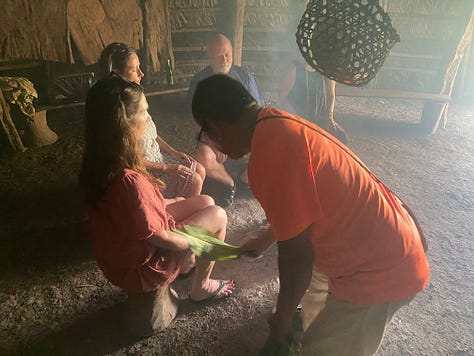
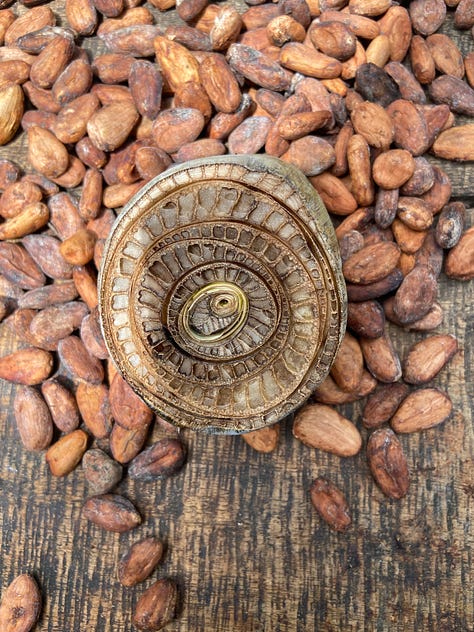


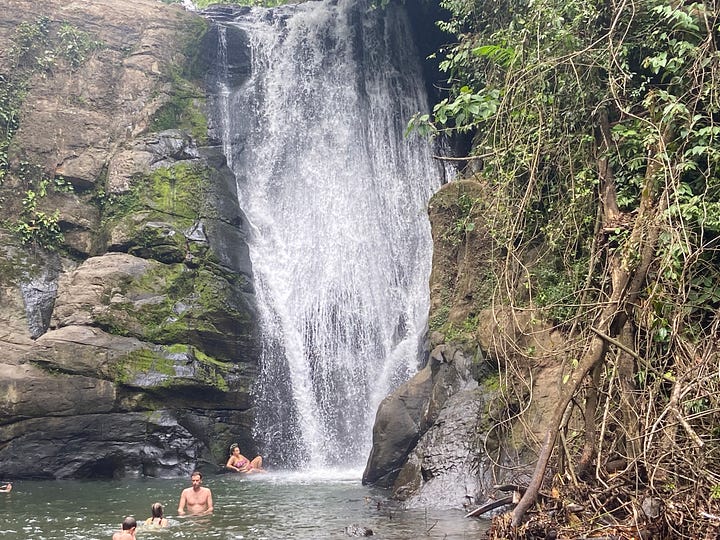
Afterward, we hiked to a hidden waterfall and swam in its cool, clear waters—a moment of pure, simple joy.
The Jaguar Rescue Center
Another highlight was our visit to the Jaguar Rescue Center—a sanctuary for injured, orphaned, and endangered animals. This is no zoo. It's a refuge, a halfway home, and sometimes a final resting place for animals who cannot return to the wild.
The JRC cares for monkeys, sloths, birds, and reptiles, offering veterinary care, around-the-clock tending, and tenderness to creatures who would not survive alone in the rainforest or the Caribbean sea.
Some stories were devastating:
A toucan with clipped feathers—flight stolen forever.
A monkey held in captivity for six years, beaten, and called “son” by his abusers.
Yet the center pulses with hope. Hundreds of animals have been healed, restored, and returned to their natural homes. The work is slow, sacred, and filled with second chances.
We met one unforgettable bird—his name escapes me, but his preferences did not. Released three times, he kept returning… each time with conditions. He’ll only eat if a female volunteer feeds him. Our guide laughed, “Smart bird. Free room, ocean view, good meals, and lovely women. Why leave?”
The JRC welcomes volunteers for stays of four weeks or longer. If the rainforest calls you, this may be your invitation to serve—and to witness wild resilience up close.
I’ve included a photo gallery to share their exquisite beauty: the neotropical rattlesnake, her cousin the tortoise (yes, a matriarchal line), radiant toucans in green and red, and a sleek wildcat with eyes like moonlight.






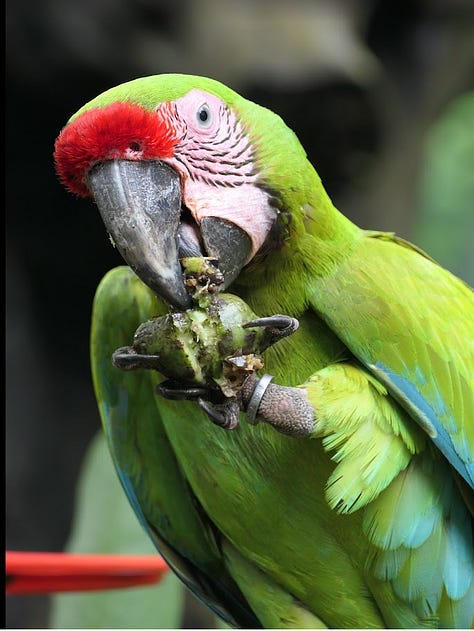

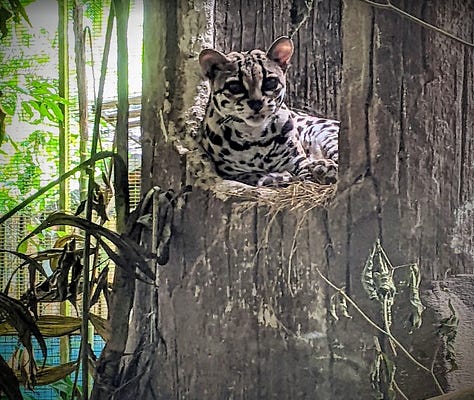
This gallery begins with a tortured monkey, curled into a fetal position—his delightful companion gently coaxing him to play.
You'll also meet crocodiles, enormous jungle rodents, and a three-toed sloth making her slow, determined ascent up a coconut tree.





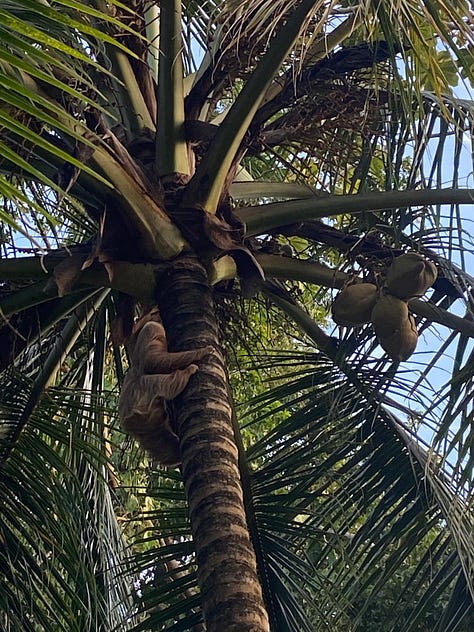
💜 I leave you with an invitation to vacation yourself.
What is your way of rest and nourishment?
I am always nourished by your likes, comments, and shares. Thank you!
🌙✨ On the Wednesday that is closest to the New Moon, I offer an online Zoom meeting for Women at 11:00 AM PST (a donation is welcome but not required). The next one is on March 26th. This is a beautiful restorative way to connect, share, and be witnessed. Learn more here.
Upcoming ceremonies and retreats are my passion and co-ed. My new website is here if you want to explore these life-changing, intimate gatherings.
“I came one way, I left another. This was the single most important journey of my spiritual path. For the first time—I belong.” — Lila Sterling
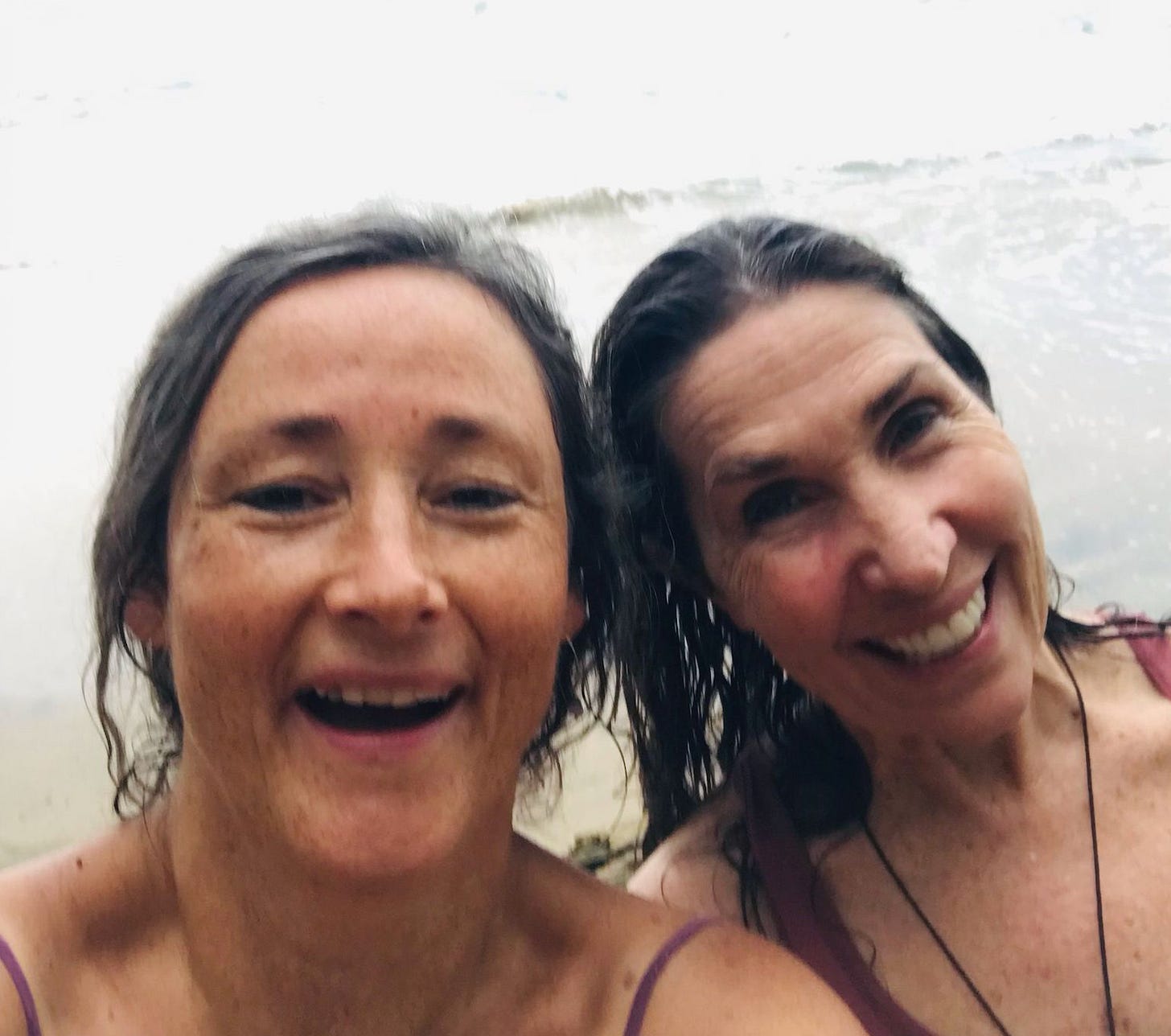
🌙✨ with love,
Prajna O’Hara, The Salty Crone
Leave a heart 💚 comment. Sing with me, put on the brass brassière, sound your drum. You know too much to pretend. We’re not going back.
🔥✨ Pachamama Song for you by Beautiful Chorus.
P.S. I appreciate the influx of new subscribers and thank the Substack friends who recommend the Salty Crone. I mention some here and encourage you to read them:
And Read the Egg.






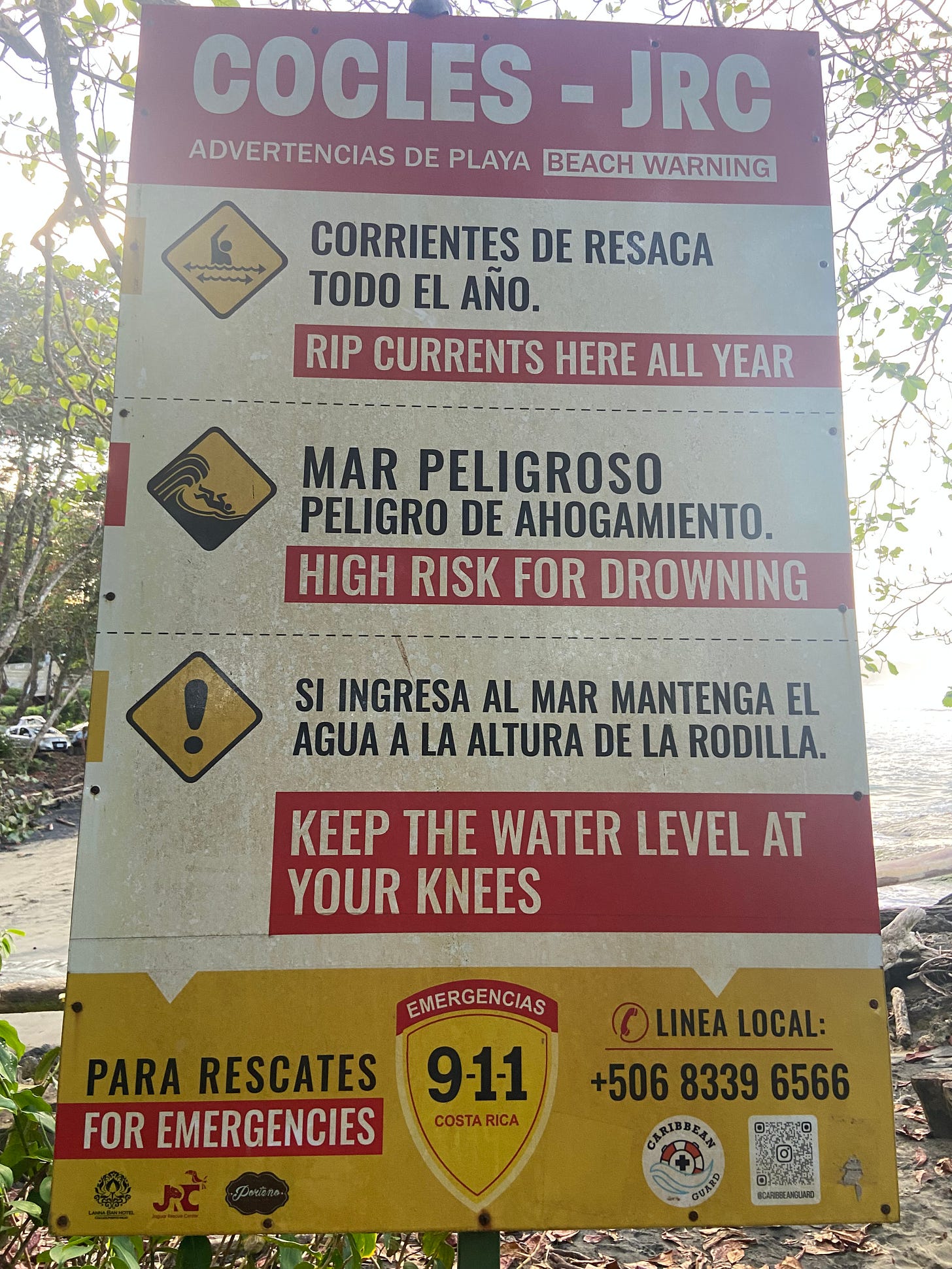
Prajna, so glad you had a wonderful relaxing vacation! You deserve it! Love hearing about your adventures.
@morven magari thank you for reading and sharing.